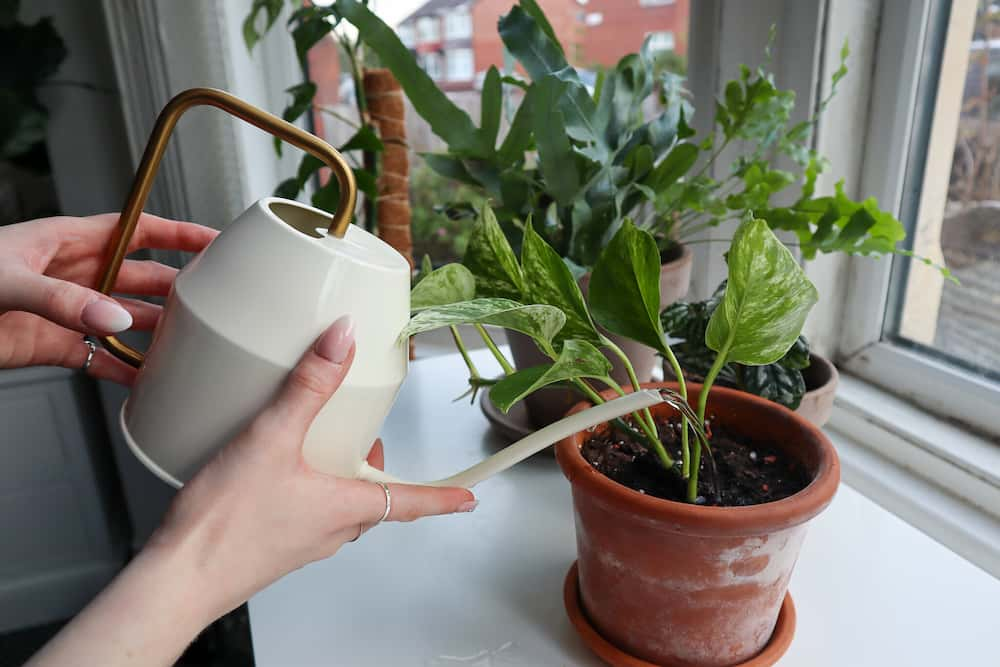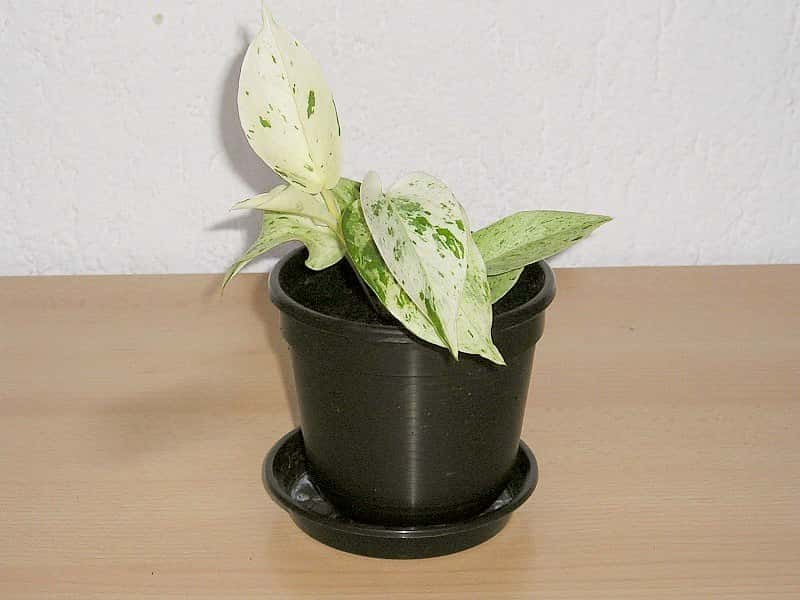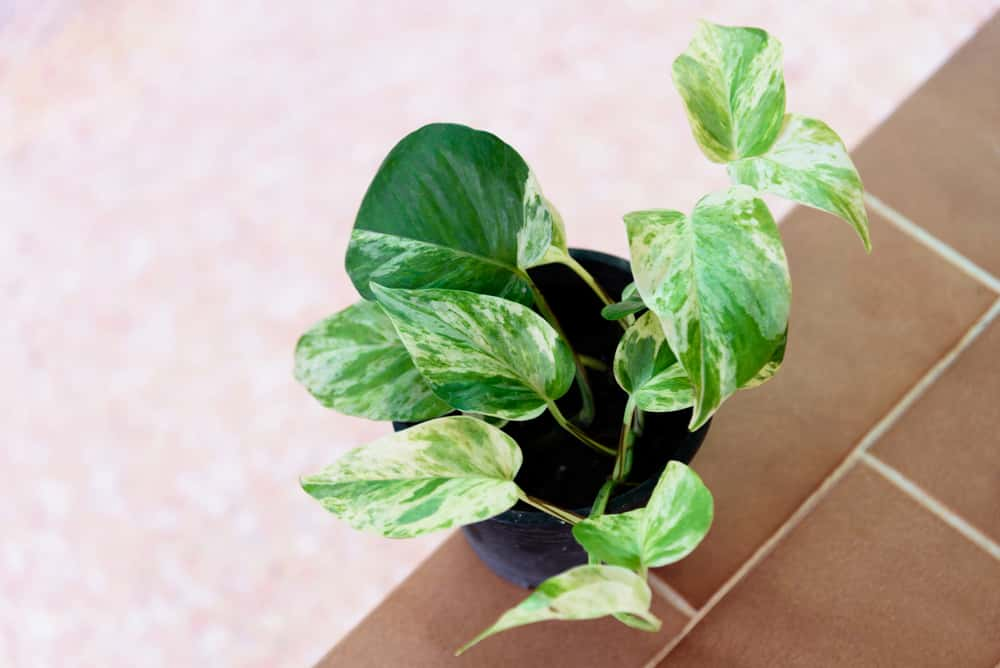Looking for an interesting and unique houseplant? Look no further than the Marble Queen pothos!
This could very well be the perfect houseplant to add to your collection. Not only is it easy to care for, but its beautifully marbled leaves will look great in your home.
In this article, I’ll provide a complete guide to caring for the Marble Queen pothos, as well as tips on how to identify them.

Table of Contents
What is the Marble Queen pothos?
A Marble Queen pothos plant is a beautiful variegated form of the regular pothos plant. It has heart-shaped leaves that are variegated with yellow, white, and green colors. The Marble Queen is a trailing plant, meaning it will grow down or anchor to another object instead of up.
If you’re looking for this type of pothos in the wild, you can find Marble Queen pothos plants in the jungles of Asia. They are epiphytes, which means they grow on other plants or trees.
In their natural habitat, they can often be found growing on coconut palms. However, they are considered an invasive species in some countries because they can quickly take over an area and crowd out other plants.
Related: Snow Queen vs Marble Queen Pothos: What’s the Difference?
The Marble Queen pothos is a very popular houseplant because it is so easy to care for. These plants make a great addition to any home or office. They are forgiving if you forget to water them and can tolerate medium light conditions. They are also very easy to propagate, so you can easily make more plants from pothos cuttings.
If you’re looking for a trailing pothos to add to your collection, the Marble Queen pothos is a great option. Keep reading for everything you need to know about how to care for this plant.
How do you look after Marble Queen pothos?
As long as your Marble Queen pothos gets occasional water and a reasonable amount of light, it will survive. This variation requires a bit more care than other pothos variants, such as the Golden Pothos. This is because variegated plants need more sunlight to maintain their colors.
Without enough light, the leaves may start to revert to all green.
Water your Marble Queen pothos when the top inch of soil is dry. These plants are drought tolerant, so you don’t need to worry about overwatering them. However, if you let them dry out too much, the pothos leaves will start to brown and drop off.

Fertilize your Marble Queen pothos every two weeks during the growing season with a half-strength fertilizer solution. You can also use slow-release pellets or granules. During the winter, you can cut back on fertilizing your pothos to once a month.
Pruning your Marble Queen pothos is important to maintain its shape and encourage new growth. You can prune off any yellow or brown leaves, as well as any stems that are longer than you want them to be. It’s best to do this in the spring or summer when the plant is actively growing.
How to train a Marble Queen pothos
You can train your Marble Queen pothos to grow in a certain direction by gently pushing the stems in the desired direction and tying them to a support such as a moss pole or trellis. This is a good way to keep the plant under control if it starts to get too big for its pot.
Training a Marble Queen pothos to climb takes patience and time, but it’s worth it for the beautiful results. You can create a stunning display by growing multiple plants in different directions.
You can also hang Marble Queen pothos in a basket in front of a sunny window for a beautiful cascading vine effect. Make sure to choose a basket with drainage holes so the plant doesn’t get too wet.
Finally, remember to regularly prune your pothos to keep it growing consistently and to make sure it stays filled out. If you don’t prune a vining or hanging Pothos plant, it may become leggy, meaning the leaves will be sparse along the stem.
How much light does a Marble Queen pothos need?
Marble Queen pothos plants need more light than their non-variegated cousins to maintain their colors. However, they will still tolerate low-light conditions better than most other plants. If your plant starts to lose its variegation, move it to a brighter spot.
You can grow Marble Queen pothos in a north-facing window, but it will do best in an east- or west-facing window. If you don’t have a bright spot indoors, you can also grow Marble Queen pothos outdoors in partial shade.

This version of the pothos plant needs more light than usual because it doesn’t contain as much chlorophyll like other plants. Chlorophyll is what helps plants absorb light and convert it into energy. So, without enough chlorophyll, the plant can’t get the energy it needs to grow.
The dark spots or leaves on the plant are the areas where there is the most chlorophyll. This is why the variegation on a Marble Queen pothos can fade if it doesn’t get enough light.
Make sure not to place your Marble Queen pothos in direct light. This may cause sunburn on the leaves, which are more delicate than other varieties of the pothos plant.
What kind of light does a Marble Queen pothos like?
The Marble Queen pothos likes bright indirect sunlight. This means it should be in a spot where it gets plenty of light, but not so much that the leaves get burned by the sun. This will ensure the optimal growth and health of your pothos plant.
An east- or west-facing window is usually a good spot for a potted plant. Keep your plant 5 feet away from the windows to make sure the light isn’t too direct.
Another way you can diffuse light in a window is by hanging a sheer curtain over the glass. This will still allow plenty of light to come in, but it won’t be as intense.
If you don’t have any windows that get good light, you can also grow your Marble Queen pothos under grow lights. These are special lights that emit the type of light plants need to grow. They’re available at most hardware stores or online.
Make sure to place your grow lights about 12 inches away from the plant so they don’t get too hot and burn the leaves. You’ll also need to leave them on for about 14 hours a day to give the plant the light it needs.
How often should I water my Marble Queen pothos?
You can water your Marble Queen pothos plant every 1 to 2 weeks. A good rule of thumb is to check the soil before watering. If the top inch is dry, it’s time to water. Similarly, if your pothos’ leaves start to droop, that’s a sign the plant is thirsty.
When watering your pothos plant, make sure to use room-temperature water. Cold water can shock the plant and cause the leaves to drop off. You can use distilled water or let the tap water sit out for a few hours before watering your plant. This will allow the chlorine to evaporate and the water to reach room temperature.
If you’re not sure how much water to give your plant, it’s better to err on the side of too little rather than too much. Overwatering is one of the most common problems people have with their pothos plants.

What happens if I overwater my Marble Queen pothos?
If you overwater your Marble Queen pothos, the leaves will start to yellow and drop off. The plant may also start to show signs of root rot. Overwatering is one of the most common problems people have with their pothos plants, so it’s important to check the soil before watering.
If you think you may have overwatered your pothos, stop watering it for a week and see if the leaves start to perk up. If they don’t, you can try repotting the plant in fresh potting mix. This will help to dry out the root system and save your plant.
When root rot sets in, it’s often too late to save the plant. This happens when the roots have been sitting in water for too long and start to decay. If you think your pothos has root rot, you can try repotting it in fresh potting mix. This will help to dry out the root system and save your plant.
Should I mist my Marble Queen pothos?
Misting your pothos plant is a good way to increase the humidity around it. This is especially important in dry climates or during the winter when indoor heating can make the air very dry. To mist your plant, simply use a spray bottle filled with room-temperature water and give it a light misting.
Make sure not to saturate the leaves or the soil. You can mist your plant once a week or as needed to increase your pothos’ humidity.
You can also place a humidifier near your plant to help keep the air around it moist. Just make sure the humidifier isn’t too close to the plant as this can cause the leaves to start drooping.
A final solution for adding moisture to the air is to group your plants together. This will create a microclimate around the plants that will help to keep the air moist.
When should I repot my Marble Queen pothos?
It’s important to repot your Marble Queen pothos every 2 to 3 years to prevent the plant from becoming rootbound. This happens when the roots start to fill up the pot and the plant becomes potbound. A rootbound plant can’t absorb water or nutrients as effectively, which affects the health of your pothos.
When repotting, make sure to use a pot that is 1 or 2 inches larger than the previous one. This allows enough space for the roots to grow without becoming potbound. Don’t choose a pot that is too large, because this can lead to root rot due to the moisture in the soil.

When you repot your Marble Queen pothos, gently remove the plant from the pot and shake off any excess soil. Inspect the roots and cut away any that are black or mushy. These are signs of root rot and should be removed to prevent it from spreading.
Never prune off more than one-quarter to one-third of the roots, as this will shock your plant. After you’ve repotted your plant, water it well and place it in a bright spot out of direct sunlight.
How do you propagate Marble Queen pothos?
Marble Queen pothos is very easy to propagate. The two most common methods are stem cuttings and root division. Choose the leaves with even variegation to maintain the beautiful coloring of your plant. The healthiest leaves are usually located near the center of the plant.
To propagate by stem cuttings, simply cut a piece of stem that has at least two leaves on it. Remove the bottom leaf and dip the cutting in some rooting hormone. Plant the cutting in a pot filled with moist potting mix and water it well. Place the pot in a bright spot out of direct sunlight and keep the soil moist. The cutting should root within a few weeks.
To propagate by root division, gently remove your plant from the pot and divide the roots into two or three sections. Replant each section in its own pot filled with moist potting mix. Water the plants well and place them in a bright spot out of direct sunlight. The roots should grow back within a few weeks.
Which method you use will depend on what you have available to you. If you don’t have rooting hormone, you can still propagate your pothos plant by stem cuttings. And if you don’t have another pot to divide your plant into, you can use stem cuttings as well.
No matter which method you use, propagation is a great way to get more plants without having to buy them. And it’s also a great way to save your plant if it gets damaged or dies.
Can Marble Queen pothos live in water?
Yes, Marble Queen pothos can live in water. However, it’s important to change the water every two weeks to prevent the roots from rotting and ensure proper oxidation. To do this, simply remove the plant from the pot and rinse the roots in clean water. Then replant the pothos in fresh water.
You can use a clear glass vase or jar to show off the roots of your plant. Be sure to use a pot that is large enough for the roots to grow without being cramped.
Colored glass works as well and will slow the growth of algae on the container’s sides. This is a great idea if you want a more hands-off approach to care.
Since the plant will be missing the nutrients it usually finds in soil, you will have to fertilize your pothos every two weeks. Use a water-soluble fertilizer or one that is made for aquariums.
Can Marble Queen pothos be outside?
In nature, Marble Queen pothos is found in the jungles of Southeast Asia. This means that it is used to living outside. However, when freely planted in North America, it is invasive and will take over any area it is in. So plant it in a pot outside or keep it indoors.
You will want to consider the climate you live in when deciding whether or not to keep your pothos outdoors. If you live in an area with cold winters, it is best to bring your pothos inside before the first frost. If it’s too dry where you live, you may want to mist your plant daily if it’s outdoors.

Keep in mind that pothos plants like the temperature to be between 60 and 80 degrees Fahrenheit. If you live in a temperate or tropical region, your Marble Queen pothos will thrive in these native conditions.
Sunlight is another consideration when growing a pothos plant outside. In the wild, these plants are normally shaded by the tall trees they grow under. So too much direct sunlight can burn the leaves of your plant.
It’s best to keep your pothos in a spot that gets partial sun or filtered sunlight. If you live in a hot climate, morning sun and afternoon shade are ideal.
Does Marble Queen pothos trail?
Yes, Marble Queen pothos is a trailing plant. This means that you can let it grow down from a hanging pot or let it trail along a shelf. Some other fun ways to display your plant are to let it climb a trellis or cascade down from a high place.
Pothos plants are known for being fast growers. So if you want to trail it, support it with enough light, proper watering, and nutrient-rich soil. Using a pot with good drainage will also help to encourage this plant to train land vine quickly.
Make sure you’re trailing your pothos in an area that will have good light conditions in the long term. You don’t want anything too dark or too bright. A spot near a window is usually ideal.
You can use a support for your pothos to help it trail in the direction you want. But be sure to use something that won’t damage the plant, like jute twine or soft wire. You can also put your pothos on a moss pole or trellis.
Finally, make sure to prune your pothos regularly to encourage new growth. You can do this by cutting back the stems to the desired length. It’s best to prune in the spring or early summer when the plant is actively growing.
Are Marble Queen pothos hard to take care of?
A Marble Queen pothos is one of the easier plants to take care of. It’s a fast-growing plant that can tolerate a wide range of conditions. Just be sure to give it enough light, water, and nutrients, and you’ll have a happy plant.
This is a good plant for those who are often on the go and can’t stick to a watering schedule. Pothos plants are also tolerant of a wide range of temperatures, making them ideal for those who don’t have perfect conditions in their home.
If you’re looking for a plant that is low-maintenance and easy to care for, the Marble Queen pothos is a great choice. The most important consideration is to make sure it has enough light since variegated plants need more light than solid green ones. Other than that, just give it a little water and fertilizer, and you’ll have a beautiful plant that will thrive for years to come.

Is Marble Queen pothos rare?
No, the Marble Queen pothos plant isn’t rare. In fact, it’s one of the most common pothos plants. The variegated leaves are what make it a bit more special and sought-after than the solid green variety. However, it is easy to find in most plant nurseries and online retailers.
When it comes to pothos plants, the Marble Queen is one of the most popular varieties. It’s easy to see why with its beautiful variegated leaves. If you’re looking for a low-maintenance plant that is easy to care for, this is a great choice.
While it’s not rare, the Marble Queen pothos is still a beautiful plant that makes a great addition to any home. If you care for it correctly, you can help it to create stunning vines that trail down from a high place or cascade over the edge of a shelf. With its easy care and fast growth, the Marble Queen pothos is a plant that will be the envy of your collection.
What’s a standard Marble Queen pothos price?
A Marble Queen pothos can range from $10 to $50 in price depending on its size, condition, and the pot it is planted in. This makes it one of the more affordable pothos varieties. Since this plant doesn’t flower, it doesn’t produce seeds, so be wary of online seed sellers.
That is, while you’re technically able to grow pothos from seed, it’s hard to say if that’s actually what you’re getting. This is why it’s much safer – and more likely to result in a healthy plant – if you get a plant or even just a cutting of a Marble pothos instead.
The price of a Marble Queen pothos can vary depending on its size and condition. If you’re looking for a large, healthy plant, you can expect to pay around $50. However, if you’re okay with a smaller plant or one that isn’t in perfect condition, you can find them for as little as $15.
Different types of variegations will also affect the overall value of the plant. A plant with more variegation will typically be more expensive than one with less. However, the difference in price isn’t usually more than a few dollars.
Where to find a Marble Queen pothos for sale
If you want to find a Marble Queen pothos for sale, your best bet is to look for one at your local gardening clubs or through online plant enthusiast groups. You can often even find cuttings of the plant for a few dollars or for free.
Some people may also give away their pothos plants when they’re moving or downsizing their collections. Keep an eye out for these deals, and you may be able to snag a Marble Queen pothos for a great price or for free.
You may also wish to keep in mind that many people get confused about the difference between the Manjula pothos vs Marble Queen pothos due to their similarities. This also means though that if you’re having trouble getting your hands on a Marble Queen, perhaps consider getting a Manjula instead if it’s easier to find in your area.
How big does Marble Queen pothos get?
You can expect your Marble Queen pothos to grow anywhere from six to ten feet in length. The plant can range from two to 3 feet in width. When given the proper conditions, this pothos can reach these dimensions in just a few years. Optimal conditions will yield a plant up to 20 feet in length.
In the wild, this plant can grow even longer. Some have been measured at over 70 feet in length and feature fenestrations, which are open spaces in the leaves that help the plant climb and resist heavy rainstorms.

Do Marble Queen pothos grow slowly?
In general, the Marble Queen pothos is a fast-growing plant that easily creates a bush or vines. If your plant isn’t growing as quickly as you’d like, it is usually because of a lack of water, sun, or your pothos plant is rootbound.
There are a few things you can do to help it along. First, make sure that it’s getting enough light. Second, fertilize the plant with a balanced fertilizer every two weeks during the growing season.
If you follow these tips, you should see an increase in growth within a few weeks.
Keep in mind that your Marble Queen plant will grow slower during the winter months. This is normal and nothing to worry about as long as the plant is still alive and healthy.
Find out more: How Fast Does Pothos Grow (and How to Make it Grow Faster)?
How do I make my Marble Queen pothos more variegated?
In order to make your Marble Queen pothos more variegated, you’ll need to provide it with the proper conditions. The plant needs bright light in order to produce the beautiful leaves that make it so popular. If the plant doesn’t receive bright light, the leaves will be mostly green with just a hint of white.
You can also prune highly variegated pothos leaves between the nodes and repot them in water or soil to create new plants with a lot of variegation.
Why is my Marble Queen turning white?
If your Marble Queen pothos is turning white, it usually indicates that it is receiving enough light and is healthy. However, if the leaves are turning entirely white or if the variegation is fading, it usually means that the plant isn’t getting enough light.
Completely white leaves on a Marble Queen pothos plant may eventually fall off because they’re actually a sign of sunburn on your pothos. If this happens, move your plant to a spot that gets indirect light and make sure to protect it from direct sunlight until the leaves have had a chance to recover.
Fading variegation can also be caused by too much fertilizer, especially in the winter months. If you think this is the case, cut back on how often you’re fertilizing your plant and see if the variegation begins to come back.

How do you keep Marble Queen white?
If you have healthy white variegated leaves on your pothos plant, the best way to keep them white is by placing them in bright diffused light. If your home can’t provide that much light, use a grow light to supplement the light that your plant is getting.
Putting your plant in a low-light condition will cause it to revert back to a dark green color. This is because the plant is trying to produce chlorophyll to make up for the lack of light.
Too much direct sunlight can also cause your plant’s leaves to bleach out and turn this into a completely white pothos. This isn’t the healthy version of white that you’re after. If this happens, move your Marble Queen pothos to a spot that gets indirect light and make sure to protect it from direct sunlight until the leaves have had a chance to recover.
Can a Marble Queen pothos revert?
Yes, it’s possible that your variegated Marble Queen pothos plant will revert to a solid green color. This usually happens when the plant isn’t getting enough light or if it’s stressed in some way. It is common for a few leaves to revert back to green while the rest of the plant remains variegated.
If this happens, you can try moving your plant to a spot that gets more light. If that doesn’t work, you can also try pruning off the solid green leaves and see if new ones grow in their place. Sometimes, all it takes is a little pruning to encourage the plant to produce more variegated leaves.
Why is my Marble Queen pothos drooping?
There are a few reasons why your Marble Queen pothos might be drooping. It may need more light, more water, nutrients, or humidity in the air. It may also be a sign of overwatering. Drooping is the plant’s way of telling you that it’s not happy.
When you correct the problem, you should see the plant start to perk back up within a day or two. However, if the problem isn’t corrected, the leaves will eventually turn brown and die.
Related: 9 Reasons Why Your Pothos Is Drooping (and How to Fix It)
Why is my Marble Queen yellow?
If your Marble Queen pothos is yellow, it could be a sign of several things. It may need more light, more water, or nutrients. It may also be a sign of overwatering or pests. Some common pests that affect pothos plants include mealybugs, aphids, and spider mites.
If there are only a few yellow leaves, prune them to redirect energy to the healthier areas of the plant. Check closely for pests and treat them accordingly. If the problem persists, you may need to repot your pothos plant in fresh soil.
